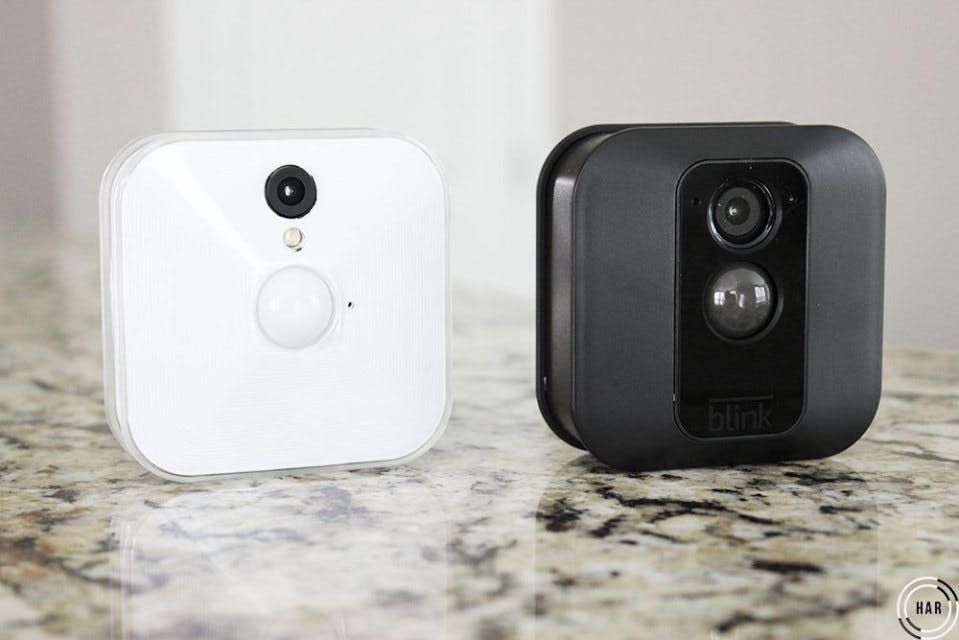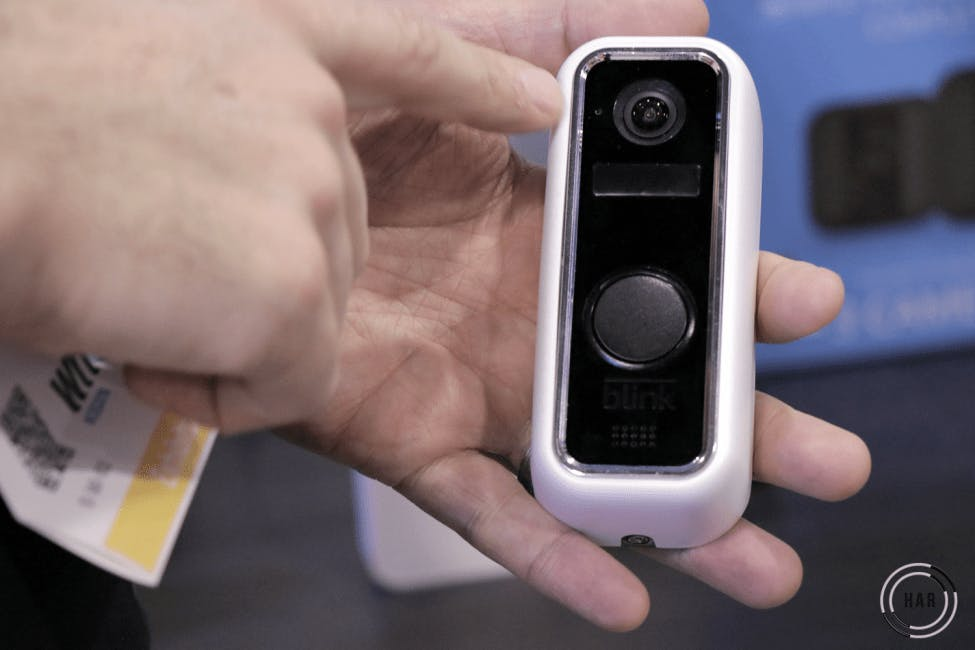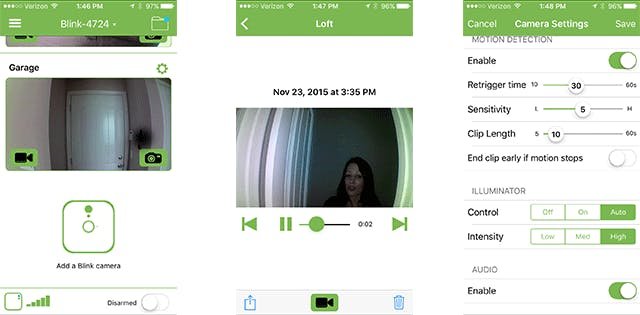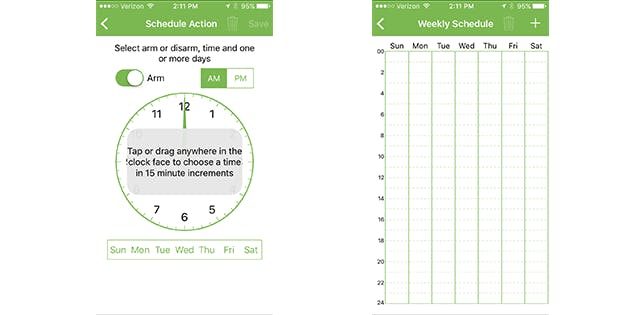
We at HomeAlarmReport have been testing Blink for over two years now and it's been performing solidly. The original Blink camera was given to us for a review, but we’ve since purchased the Blink XT on our own. With big changes recently announced (Blink was purchased by Amazon), it’s time to take a fresh look at this battery-operated security camera.
Blink vs. Blink XT
Blink XT is the newest Blink Camera. It’s not a replacement for Blink, but rather a supplement. In so many ways, it appears superior. And in so many ways, it’s still the same.
| Blink | Blink XT | |
|---|---|---|
| Resolution | 720p | 1080p |
| Night Vision | Illuminator | IR LEDs |
| Field of View | 110° | 110° |
| Usage | Indoor | Indoor/Outdoor/ IP65 rated |
| Promised Battery Life | 2 Years | 2 Years |
| Actual Battery Life | 2 Years | 2 Months |
| Sensors | Motion and Temperature | Motion and Temperature |
| Smart Detection | Activity Zones | Activity Zones |
| Encoding | H.264 | H.264 |
| Color | White | Black (Trim White, Utility Gray, and Brick Red Skins Are Also Available For $24.99 Each) |
| Where to Buy | Buy Here | Buy Here |
The two cameras can work alone or together, but either way, you’ll need to connect them to a Sync Module, a separate device that remains plugged into a power source. The Sync Module is one of the reasons why Blink has such a long battery life. Instead of connecting directly to your Wi-Fi network, Blink and Blink XT rely on the Sync Module for communication. It's responsible for streaming videos, sending clips to the cloud, and sending app commands to your Blink cameras. For example, if you enable motion detection from the app, the command will go straight to the Sync Module over the internet and the Sync Module uses its proprietary low-power frequency to relay the command to your camera.
Blink Video Doorbell

Besides Blink and Blink XT, there's another Blink camera coming soon: a video doorbell. Although it was removed from Blink's website, a recent FCC filing by Blink and Amazon indicates that they're finalizing the doorbell.1
Based on the initial features announced, it’s a fine doorbell, with a tempting price ($99.00 without a Sync Module, $129.99 with a Sync Module). And yes, it does require a Sync Module. However, we're not planning on testing it. For starters, we're satisfied with our Ring Video Doorbell. By the way, Ring is also owned by Amazon and Ring is a much more established doorbell company. Second, our experience with Blink XT has shown us that Blink’s amazingly long battery life isn’t so amazing when the camera is exposed to the outdoors, where the motion activity level is higher. This wouldn’t be as big of a deal if Blink Doorbell was wired or if it offered a rechargeable battery, but it doesn’t.
The Blink Doorbell will use the same two AA 1.5V Lithium batteries as the Blink Security cameras. While you can wire the doorbell so that it rings your existing chime, this will not keep the camera charged, it will only extend the camera’s battery life.
Finally, Blink hasn’t been so great about launching promised products in their promised form and they’ve struggled to launch products on time.
That said, let’s talk hardware. The Blink Video Doorbell is an HD camera that offers two-way audio. If someone rings your doorbell, you can use the Blink app to talk to your guest. If you don’t have an existing door chime, you can buy one from Blink (pricing TBD). The camera will capture ring events and store them in the Blink cloud. The doorbell, like all Blink cameras, includes free cloud storage.
In addition to ring events, the camera can monitor for motion events. According to David Laubner, Head of Digital Marketing & Sales for Blink, you will be able to turn motion off and keep ring events on. Though you can choose to turn ring and motion on or off, there’s no word yet on if you will be turning notifications off or monitoring off. Either way, if you have another outdoor camera set up to monitor, we suggest you turn Blink’s motion off as its battery life is highly contingent upon usage and motion events would trigger more use.
Motion Alerts and Video Storage

All Blink cameras include motion detection backed by Activity Zones that is sensitivity adjustable.
Activity Zones is a new feature, launched well after we originally tested Blink. It masks off areas you don’t want your camera to monitor for motion. Unfortunately, Blink’s Activity Zone feature is slightly different from what other cameras offer. You can’t draw the zone or even customize its shape. Instead, the camera’s frame is segmented into a 5-by-5 grid. Each of the 25 cells represent an activity zone. It’s not perfect, but it’s progress.
From the app (iOS and Android), you can also:
- Enable/Disable Motion
- Set the Retrigger Time Between 10 and 60 Seconds
- Adjust the Sensitivity
- Customize Activity Zones
- Adjust the Recorded Clip Length (5 and 60 Seconds)
- Set the Clip to End Early if Motion Stops
And what we like most about Blink’s motion is that it’s “always-on.” You might not realize how important this is until you test other battery-powered cameras. We tested Canary Flex, as an example, and was disappointed to find the camera often missed important events because it sleeps through them. Blink doesn’t have that problem. In fact, we looked through a years’ worth of recorded footage (yes, it can potentially keep footage for a year) and found that Blink captured the action effectively.
So how long can Blink keep footage? It keeps footage until your storage limit is reached. Footage is stored on Blink’s server where you are allowed to store up to 7,200 seconds of video. If you decide to keep the clip length at five seconds, you can save 1,440 clips. Once you run out of space, your older events are automatically overwritten by newer events. If there is a clip you want to save, simply download the video or email it to yourself from the mobile app. If you prefer to take charge of your allotted storage, you can also delete saved clips manually. Finally, though the Sync Module supports a Flash Drive, the ability to use it for local storage is still not available.
Of course, Blink isn’t perfect. It’s missing a few key features.
- You can’t record on-demand.
- Lacks Geofencing, though you can set this up indirectly through IFTTT.
- It lacks two-way audio.
- As a company, they haven’t always delivered promised features/products. (USB Storage, Geofencing, Motion Triggered Siren, Etc.)
- Push Notifications are not sent until motion is finished recording. They are NOT instant.
Creating Schedules

Though Blink has decided to charge for geofencing (the ability to automatically ask the camera to arm and disarm based on your presence), they have left us with three new freemium features.
First, you can create a schedule. If you wake up and come and go around the same time every day, this might work for you. The biggest problem here is that a schedule will arm all of your cameras. You cannot pick and choose different schedules for different cameras.
Second, they offer integration with Amazon Alexa. By enabling the “Blink for Home” Alexa skill, you can arm and disarm your system using your voice. You can also ask it to name your last recorded motion events. While disarming a camera with your voice might sound like a security risk, Blink has added protection by requiring a verbal, 4-digit pin.
Third, they’ve launched their own IFTTT channel. Through IFTTT, you can connect Blink to hundreds of other devices and services. You can also create geofencing rules to arm and disarm your cameras based on your presence via Life360. However, after running an IFTTT geofencing rule on our indoor cameras for months, we’ve found it to be somewhat unreliable. And just like schedules, an IFTTT applet will arm and disarm all of your cameras. There is no way to choose individual cameras through IFTTT.
About That Battery Life
The original Blink cameras gave a solid two years of battery life. The XT, on the other hand, hasn’t fared so well outdoors. The first set of batteries lasted around two months. After that, we made adjustments to the camera to reduce the number of alerts received. Unfortunately, this made little difference. The second round of batteries lasted a mere 1.5 months. The third set didn’t last much longer.
Disappointed, we reached out to Blink for feedback. Team Blink suggested we use only new, non-rechargeable AA Lithium batteries stating that alkaline based, Lithium Ion/Li-ion, and rechargeable batteries will only drain the camera faster. They also suggested that we power the camera using a micro USB cable and USB power adapter, which sort of defeats the purpose of buying a battery powered camera.
However, this doesn’t explain why there is such a great discrepancy between promised battery life (2 years) and actually battery life (2 months). According to Blink, standard use is defined as 40,000 seconds of recorded motion clips and live view sessions. We had surpassed this number in two months. That said, Blink XT is going to work best in lower traffic areas or even indoors. We also suggest looking into the new Activity Zone feature which will help reduce false alarms and prolong Blink’s battery life.
Blink + Amazon
Blink was acquired by Amazon in December of 2017. As to what that means for Blink, during our CES visit, Laubner had no comment other than, “It’s too soon to tell.” We asked how the merger would affect their cloud storage offer. No comment. We asked how the merger would affect customer service. No comment. We asked if they planned to continue to use their own app or if they planned to swap to the app used for Amazon Cloud Cam. No comment. The ending statement to our barrage of comments, “As of right now, everything is business as usual.”
| Arlo Pro | Arlo Pro 2 | Blink XT | |
|---|---|---|---|
| Resolution | 720p | 1080p | 1080p |
| Adjustable Video Quality | |||
| Field of View | 130-degree | 130-degree | 110-degree |
| Live Stream On-Demand | |||
| Night Vision | |||
| Zoom | Digital | Digital | Digital |
| Two-Way Audio | |||
| Other | Records Sound, Detects Sound | Records Sound and Detects Sound. When plugged-in, offers Activity Zones and Look Back | Records Sound, Temperature Alerts, Activity Zones |
| Rating | IP65 rated | IP65 rated | IP65 rated |
| Camera Power | Rechargeable Battery (Indoor or Outdoor), Power Supply (Indoor Only), Arlo Solar Panel | Rechargeable Battery (Indoor or Outdoor), Power Supply (Indoor Only), Arlo Solar Panel | AA Batteries or micro USB cable and USB power adapter |
| Battery Life | Tested at 2-5 Months | Tested at 2-5 Months | 2 Years (Lasted Two Months During Testing) |
| Requirements | Base Station, Ethernet, Power | Base Station, Ethernet, Power | Sync Module, WiFi, Power |
| Siren | Built into base station. | Built into base station. | Extra |
| Free Cloud Storage | 7 Days | 7 Days | 7,200 Seconds |
| Premium Features | 1. Extended Phone Support, Additional Cloud Storage, Additional Camera Support. 2. Person Detection with Activity Zones and Rich Notifications via Arlo Smart | 1. Extended Phone Support, Additional Cloud Storage, Additional Camera Support. 2. Person Detection with Activity Zones and Rich Notifications via Arlo Smart 3. Continuous Video Recording with a Paid CVR Plan. | Native Geofencing, Professional Monitoring, Sensors, 4G Backup, Advanced Motion Detection |
| Local Storage | USB Backup or External Hard Drive | USB Backup or External Hard Drive | USB Coming Soon |
| iOS and Android App | |||
| Web Portal | |||
| Alerts | Push, Email, IFTTT | Push, Email, IFTTT | Push, IFTTT |
| Works With | SmartThings, Wink, Stringify, IFTTT, Amazon Echo Show, Echo Spot | SmartThings, Wink, Stringify, IFTTT, Amazon Echo Show, Echo Spot | Amazon Alexa, IFTTT |
| Buy Here | Buy Here | Buy Here |
Motion Detection Performance
When it comes to detecting motion, Arlo Pro and Blink approach the task differently. If your greatest concern is catching the most events with accuracy, Arlo wins. If your greatest concern is making sure the camera wakes up in time to record an event in its entirety, Blink XT wins with one exception: Arlo Pro 2 offers a pre-buffer feature that will record the three seconds before motion is detected. The biggest catch here is that Pro’s pre-buffer feature only works when the camera is plugged-in, and the power cord is not weatherproof.
| Arlo Pro | Blink XT | |
|---|---|---|
| Adjustable Clip Length | 10-120s | 5-60s |
| Motion Triggered Clip Length | Record until activity stops (up to 300 sec). | Can end clip early if motion stops. |
| Notification Sent | Instantly | Once Recording Stops |
| Arm Individual Cameras | Manually or Via Rules | Manually |
| Record On-Demand | ||
| Adjustable Sensitivity | ||
| Schedules | ||
| Geofencing | Via IFTTT (Native Geofencing Will Require a Subscription) | |
| Person Detection | Via Arlo Smart |
After running the cameras side-by-side using different sensitivity levels, we found that Arlo was slightly more accurate at detecting events during the day and at night and delivered fewer false alarms. In part, because it offers a motion sensitivity test that allows you to set the motion detector’s range accurately. As an example, you can customize the range so that it only detects motion on your porch while ignoring the street. Though you can adjust Blink’s motion sensitivity level, you can’t adjust the motion detector’s range. Adjusting Blink’s sensitivity adjusts what it considers to be movement, not how far the detector reaches to find movement.
In addition, Arlo has Arlo Smart, which gives Arlo the ability to detect people and adds Activity Zones. This feature, however, requires a monthly subscription of $2.99 per camera. If you use Arlo Pro 2 indoors and plugged-in, it also offers activity zones. You can set up to three zones. The camera will monitor the zones while ignoring motion outside the set zones. Again assuming you have the camera plugged-in, you can pay to add a continuous video recording (CVR) plan. On the other hand, Blink offers Activity Zones for free.

Blink wins with its Instant On feature. Unlike Arlo, this features works even when the camera is unplugged. A common problem with all battery-powered cameras is that they sleep between events to conserve battery life. Blink’s Instant On allows the camera to wake up and start recording within seconds. There are times when Arlo fails to wake up in time to actually record something useful. For example, the picture below. We asked one of our testers to walk across the camera's field of vision. Arlo did detect our tester, but it didn't wake up and record in time to capture her face.
Arlo also has an edge in that they allow you to create modes involving individual cameras or groups of cameras. For example, you might have a rule that arms your outside camera, but not your indoor cameras. With Blink, schedules and automation are one-size-fits-all. You can manually disarm individual cameras from within the app, but you can’t automate without involving all cameras connected to your sync module.
Finally, Arlo’s battery is rechargeable and they sell a solar panel.With Blink, you have to replace the battery every time it runs out of juice.

Everything Else
One Arlo base station can support fifteen cameras, but your service plan will dictate how many cameras you can use. The free plan supports five cameras. Arlo’s Premier Plan for $9.99 per month supports ten cameras, and the Elite plan for $14.99 per month supports fifteen cameras.
On the other hand, you can connect up to ten Blink or Blink XT cameras to one Sync Module.
Can it read a license plate?
If Blink is placed correctly, you might be able to read the license plate number of a parked car. During the day, we were able to read a license plate that was 20-feet away using the digital zoom feature.
Support Caution For Both Cameras
We give Arlo a B+ for support and Blink a C. Arlo has a leg up here as they do offer phone support for the first three months. After that, you have four options:
- Pay for a premium plan to gain access to extended phone support.
- Ask the Arlo Community via their website.
- Use Live Chat.
- Send them an email.
Arlo’s email support is slow and there are often communication challenges. It took them four days to troubleshoot an issue we had with two-way audio.
Blink, on the other hand, is harder to get in touch with. They also have a community, though not as active as Arlo’s. And the only way to reach tech support is to fill out an online form. In our experience, once we had an agent, it was hard to continue communication as we weren't able to reply via email. Instead, each time, we had to fill out a new support form.
How long is the power cord?
The power cord for the Arlo Base Station is 6 feet long. The included Ethernet cable is 6.5 feet long. The USB cord that connects to the Blink Sync Module is 40.5 inches long.
Camera Range
Building materials, walls, and doors will all impact a camera’s range. In general, you can place a Blink camera up to 100 feet away from the sync module. Arlo cameras can be placed up to 300 feet away from the base station.

